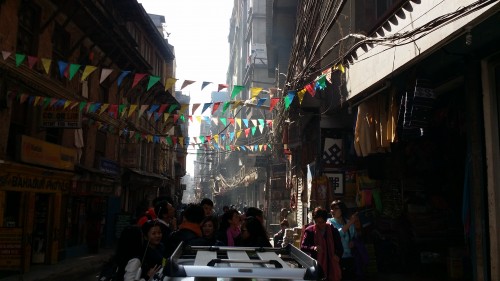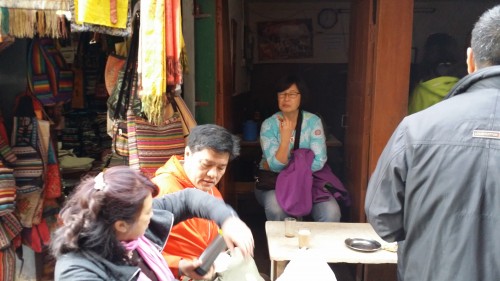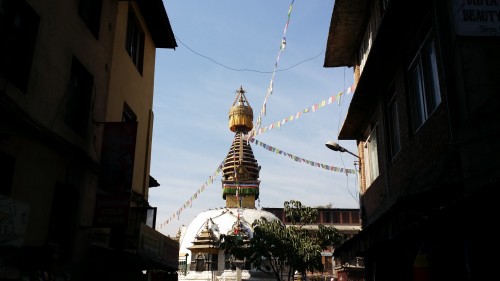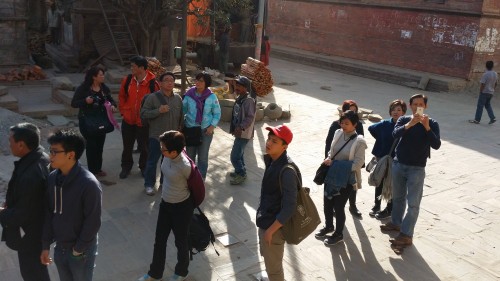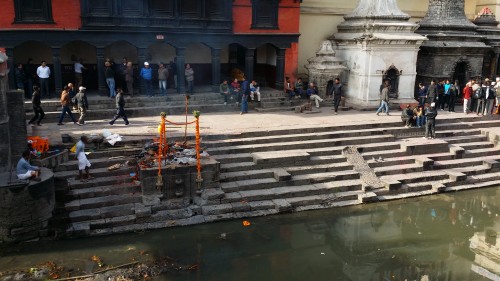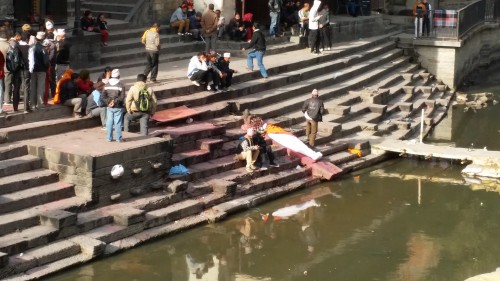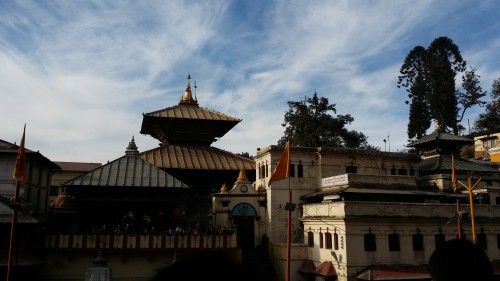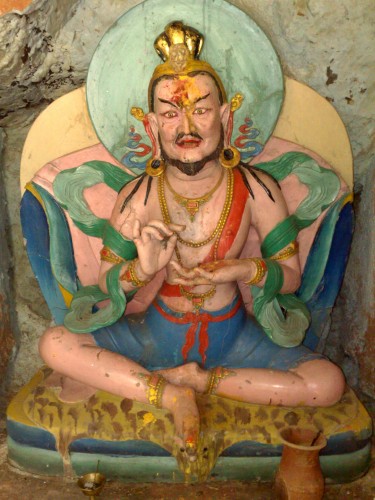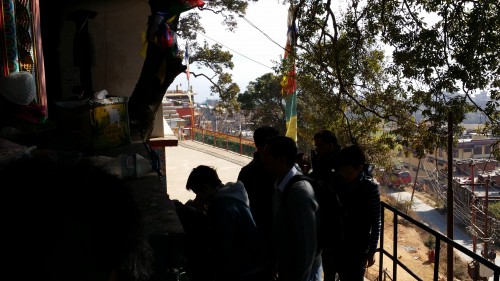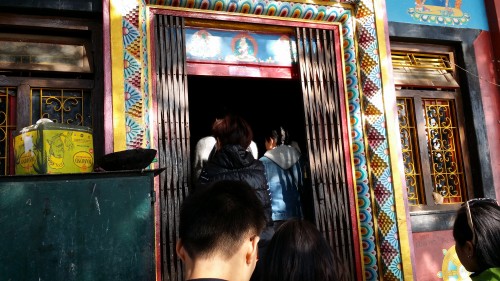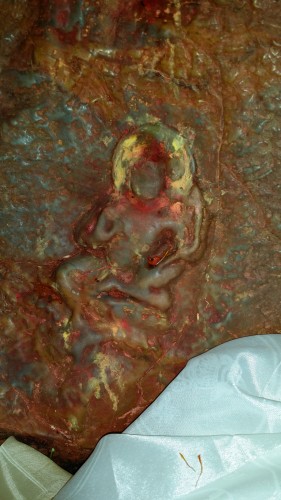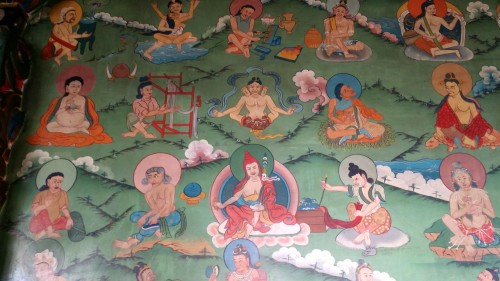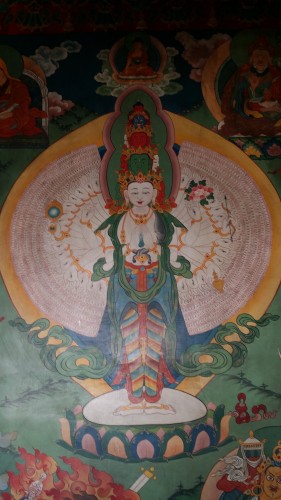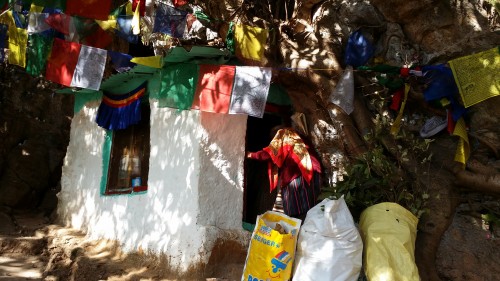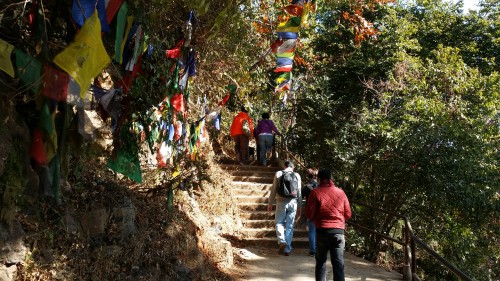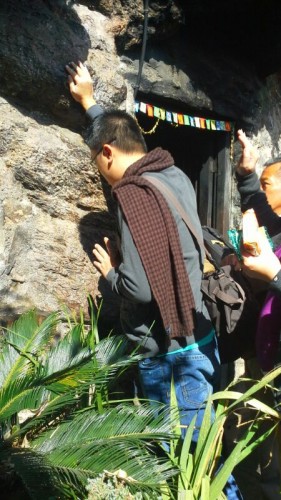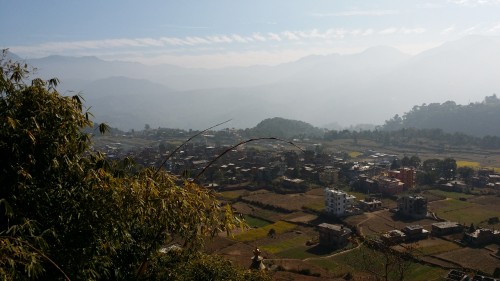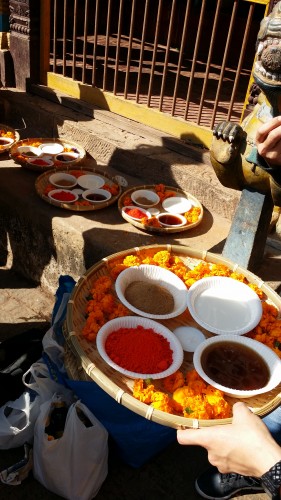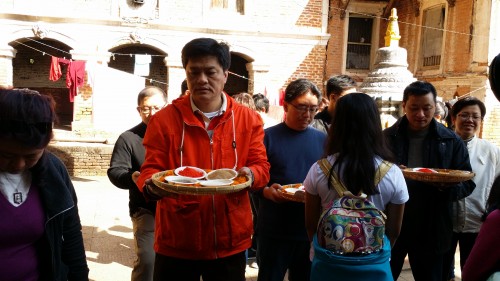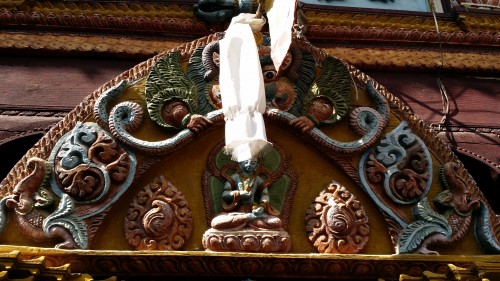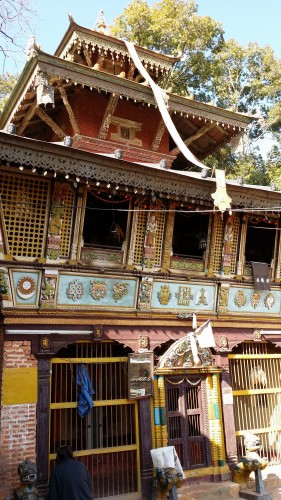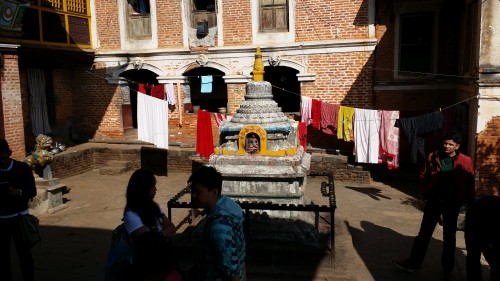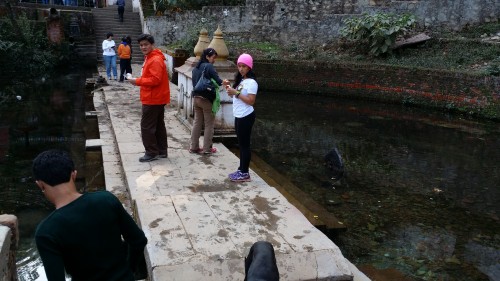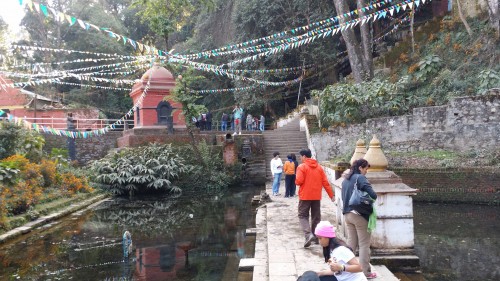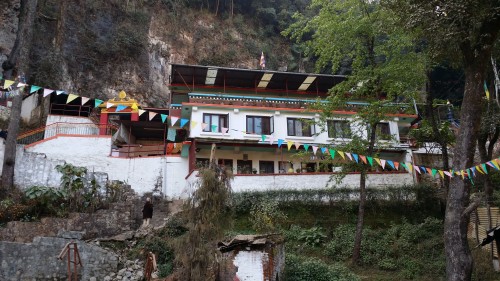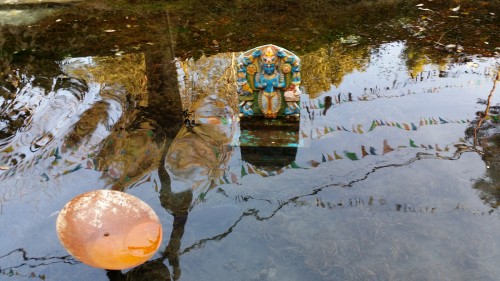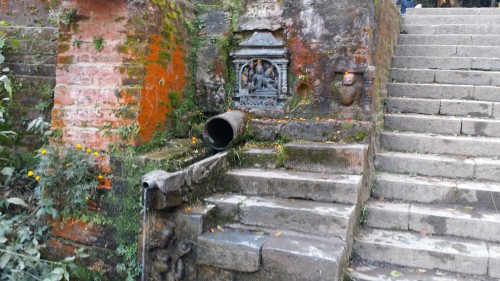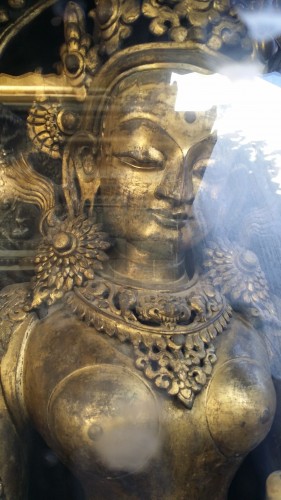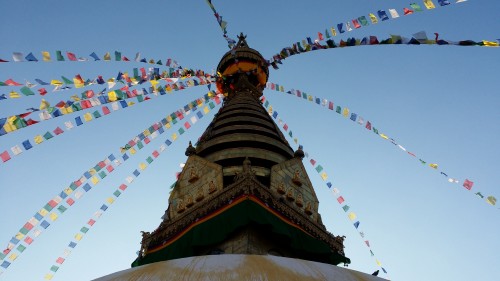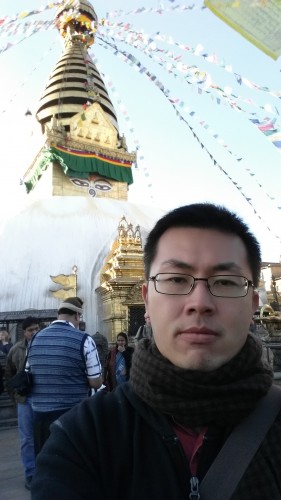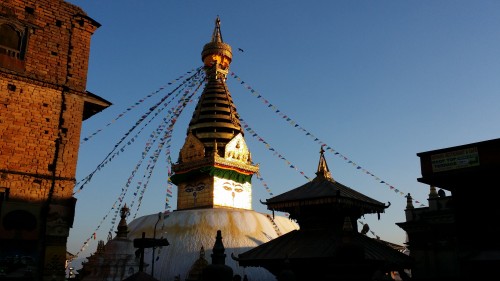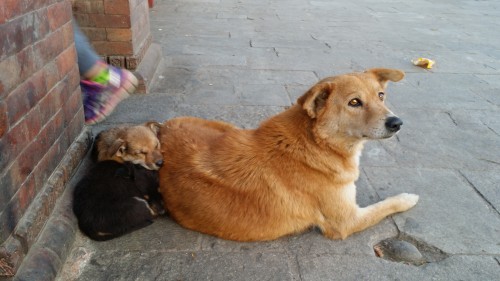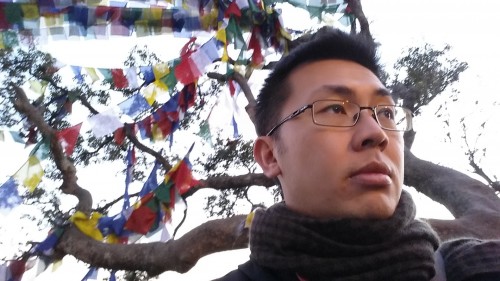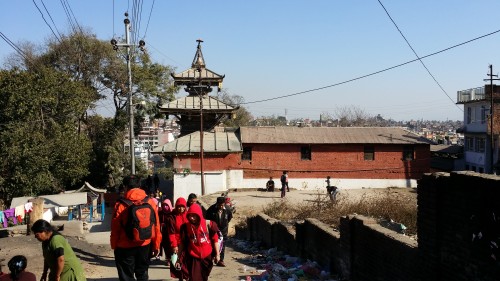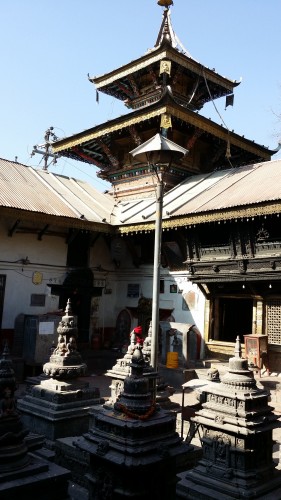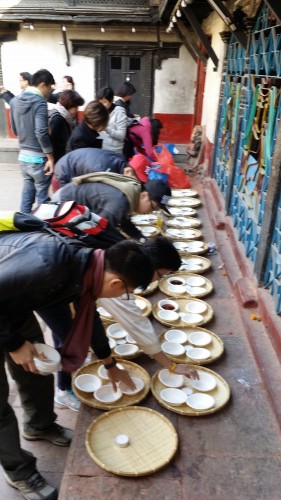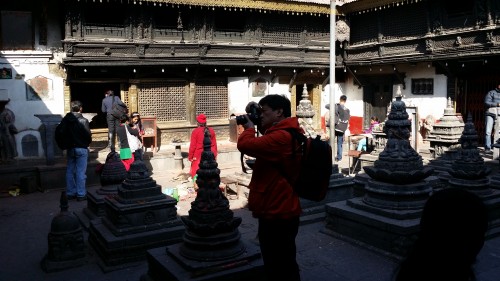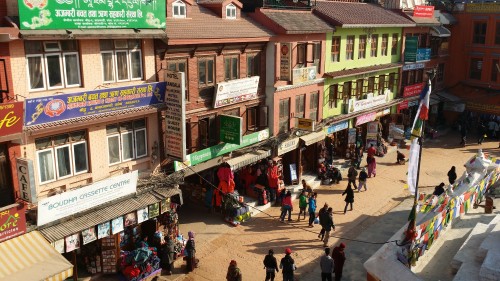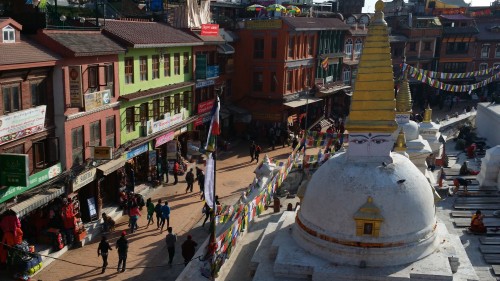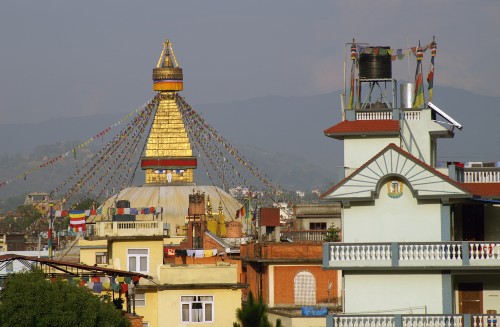A Vajrayogini pilgrimage (part 2)
18 Feb
The narrow street leading to Tahithy Chowk
Well, its been awhile and I am finally coming up with the second installment of the earlier post of the recent pilgrimage to Nepal. The pilgrimage was in December but fortunately, I have pictures and recall some interesting stories and did further research on further significance of these locations that would be interesting for any of you intrepid pilgrims who may want to venture off the beaten path.
The first is the Kathesimbhu Stupa that incidentally wasn’t really part of the itinerary but one that I brought some of the male pilgrims as the females were off shopping at a fabric shop at Tahithy Chowk. The previous post were on Jana Bahal and Itum Bahal, both of which were in the vicinity of Tahithy Chowk. This little 17th century stupa, tugged neatly in relatively tight courtyard off a narrow street is rather unique because it resembles Swayambhunath Stupa. I had discovered it by accident on one of my previous trips to Nepal and interestingly, it was built to resemble Swayambhunath and was actually believed to be built with the leftover raw materials used in constructing Swayambhunath.
The pilgrims taking a break at a teahouse near the entrance of the Kathesimbhu Stupa
Actually, Kathesimbhu means “Kathmandu Swayambhu”. Perhaps, it was built for the old and lame so they would gained the same blessings as a pilgrimage to Swayambhunath hill. Although the present stupa dates from the 17th century, the many votive chaityas (stupas) and sculptures of deities of the Mahayana pantheon reveal the site to be considerably older. A prominent figure of Avalokiteshvara is dated to the 9th century. A nearby Sigha Bahal is a Theravaden monastery while a nearby Tibetan-styled monastery caters to the Mahayana tradition with a rather beautiful 1000-armed Avalokiteshvara as a central icon in the main prayer hall.
The Kathesimbhu Stupa loomed over the courtyard that unfolded from a narrow entrance off Tahithy Chowk
However, there is another legend that gives a slightly different account of the stupa’s origin. This account tells of a stupa built in the Indian city of Benares (Varanasi) and the celebrated Reverend Vakvajra was persuaded to come from Nepal to bless the stupa with a few drops of water from the Ganges river. This simple ceremony failed to satisfy the people of Benares and they had little regard for it. Vakvajra therefore decided to move the stupa with the aid of an elephant but failed. Then, Vakvajra recited a mantra, whereupon the stupa moved of its own accord and followed him back to Sigha Bahal in Kathmandu.
Unfortunately, I didn’t take much pictures during this trip but I do recall taking more pictures on a previous trip. If I do find those pictures, I would blog them. Naturally, we did the customary circumambulations and mantra recitations around the stupa before moving on.
Pilgrims gathering outside the gates of Pashupatinath
Next stop is Naropa and Tilopa caves near the Pashupatinath Temple complex. This begins pilgrimage to a holy site associated with the yogin who revealed the practice of Vajrayogini practice that is practiced today – Naropa. Pashupati is one of the holiest Hindu sites on the Indian subcontinent. Pashupati is regarded as the most sacred temple of Hindu Lord Shiva and it dates back to 400 A.D. The richly-ornamented pagoda houses the sacred linga or phallic symbol of a special avatar (emanation) of Lord Shiva. Thousands of pilgrims from all over the world come to pay homage to this temple, that is also known as ‘The Temple of Living Beings’. It is a UNESCO World Heritage Site and the inner sanctum of the temple houses the most sacred phallus (lingam) of Pashupati that’s adorned with four faces.
Pashupatinath is Nepal’s most renowned Hindu cremation site. In Hindu culture,the deceased is wrapped in cloth and placed on bamboo litter and bodies are delivered by barefoot pallbearers accompanied by the male relatives. The eldest son from the family performs the cremation ceremony and the dead body is burnt on the ghats (terrace steps) of Pashupati.
A few hours later the ashes are collected and swept in the river which will join the Holy Ganges eventually. The pictures above reveals this process. We witnessed this while crossing the bridge and as I explained to the pilgrims, this is an excellent moment to contemplate on our mortality.
While contemplating death, I snapped this picture of the inner sanctum of Pashupati with its 2-tiered roof. The holiest phallus of Pashupati is enshrined within. Naturally, only Hindus are allowed into the temple itself and I am sure only the temple priests are allowed into the sanctum to perform the pujas and stuff. We walked down the river towards Surya Ghat where Naropa and Tilopa’s caves were.
Here’s a neat description of the location of these caves by Keith Dowman :-
A hundred yard up river from Arje Ghat, accessible by paddling across the river or by a tortuous path down from Kailash, is Surje or Surya Ghat. Above this ghat are several caves carved from the living rock. This place of solitude has been the home of yogins down the centuries, and some of the caves are still inhabited by contemporary successors. Legend names two of these caves after the great Buddhist mahasiddhas Tilopa and Naropa, sadhu-yogins of the tenth century, and progenitors of a lineage of Buddhist tantra that became the Tibetan Kagyu school of the Karmapas.
Naropa’s statue is all that remains of Naropa’s sacred presence in the cave.
Found this story on the net that resembled the story that Rinpoche told us before during a pilgrimage:-
The son of a liquor merchant and the product of a mixed-caste union, Naropa grew up to become a wood gatherer. Unhappy with his life of gathering wood and selling at the market, Naropa heard word of the great teacher Tilopa and began to seek him. After many years of searching, Naropa finally met Tilopa by chance on a dusty road and immediately began to respectfully bow to him and inquire about his health. Tilopa angrily struck Naropa on the face and told him that he was not his teacher.
Naropa didn’t give up and continued to follow Tilopa, taking his abuse without complaint, the whole time never receiving one word of spiritual instruction. It continued in this manner for twelve years with Naropa’s faith never faltering.
One day Naropa was begging for food at a wedding feast whose host was very generous. The host gave him eighty-four different types of food, one of which was a delicious and rare delicacy. Tilopa, in turn, was pleased with the special dish, and giving Naropa the smallest amount of praise he asked him to go get more. Having never before received any praise from Tilopa, Naropa was overjoyed and returned to the wedding to fetch more of the dish. He returned four times and each time was given the food without complaint. On his fifth trip he felt ashamed to continue but also could not bear the thought of displeasing his master. He decided to steal one more bowl. Tilopa was delighted with Naropa’s determination and perseverance and calling him ‘my diligent son’. He instructed Naropa in meditation and gave him initiations and blessings. After six months of practice, Naropa achieved supreme Mahamudra and became a respected Guru and educator, known throughout the world. After years of selfless work with thousands of students, Naropa rose to the Dakini’s paradise.
Naropa figures prominently in many lineages of tantric practice – especially honoured in the early Marpa Kagyu lineage of teachers. The Tibetan Marpa Chokyi Lodro (1012-1099), founder of the Marpa Kagyu Tradition, having journeyed three times to India, studied extensively with Naropa. In the Sakya School Naropa is honoured as the originator of an important cycle of Vajrayogini practice counted as one of the very special teachings of Sakya. Lineages that include the name Naropa weave through all of the Sarma Schools of Tibetan Buddhism.
Needless to say, pilgrims were taught to focus their aspirations at this holy spot for developing Naropa’s pure devotion to his Guru because it is his devotion to his Guru that led him to become fully awakened.
No visit to Kathmandu is complete without a day trip to Pharping, a little hill that has several holy spots. Upon arrival, one reaches upon a little temple built into the side of the Pharping hill that seemingly enshrines a bare rock that smothered in red Sindhura powder. Upon closer inspection, one would perceive a large roughly carved image of Ganesha and a smaller image of Tara.
However, this is not statues carved by artisans but spontaneous image that appear out of the rock. Noticed by pilgrims for over 3 decades now, Tibetan monks have built a chapel over it and monks regularly perform Tara pujas to it. Apparently, the image of Tara becomes steadily clearer over time. Tibetans calls this phenomena rangjung or ‘self-arisen’.
The White Chenrezig statue in Thamel called Seto Macchendranath is believed to have appeared in this manner. According to Rinpoche, such phenomena occurs due to powerful meditators have lived in the area and the images are a result of their meditational practices.
Frescoes of the famous 84 Mahasiddhas cover the wall of the adjoining room next to the shrine of the Self-arisen Tara.
This is another fresco image of 1000-armed Avalokiteshvara rendered in the Tibetan style adorning the room next to the self-arisen Tara.
The Tara temple was just the first stop and after making numerous offerings of butterlamps, mantras and aspirations, the pilgrims ascended a flight of steps. We were on the way up towards the Asura cave. Midway, we came across one of many little hermitages built by meditators in their quest to soak up the spiritual energy of the place and maintain their meditational practice.
Prayer flags abound lending a tranquil spiritual energy to the Pharping hill. Thus, the pilgrims quietly shuffle up the stairs leading to the Asura cave. The cave is currently in the confines of a narrow monastery that was built by the hill that seemed equiped with a prayer hall, butterlamp house, retreat room and various amenities. It seemed to have raised more funds and there’s a gate now leading to the cave. Pilgrims would have to file pass the gate and stone steps leading to the cave.
We have reached the Asura cave at last and just outside the cave is a handprint of Guru Rinpoche sealing the blessings of having attained Mahamudra siddhi or enlightenment in this cave. Thus, it is extremely popular with Tibetan Buddhists seeking the blessings of Guru Rinpoche. The cave is just a narrow chamber with darkened walls due to hundreds of butterlamps offered daily. There’s an image of Guru Rinpoche along with his yidam, Yangdak Heruka.
After butterlamps, mantras and prayers at the Asura cave, we headed down a different flight of steps that led to a different side of the hill. We were heading towards the famous Pharping Vajravarahi (variant lineage of Vajrayogini) temple. Unfortunately, I was not able to snap a picture of the shrine of this Vajravarahi statue with a single leg up. However, a picture can be found in my Vajrayogini Coffee Table book. However, here are some really neat pictures of the pilgrims setting up very extensive offerings that Rinpoche used to prepare when worshipping Vajrayogini.
The woven tray has a bowl of tea, milk, red sindhura powder and powdered juniper incense. with a tea light in the middle. This is apparently what Rinpoche had recommended as an Indian/Nepali-styled offerings to Vajrayogini.
The male pilgrims carried the trays of offerings up to the second floor, where the actual shrine in on the second floor of the main temple building. The image itself is in the inner sanctum and pilgrims get to circumambulate around her via a dark passageway. Fortunately, there’s a wider hall on the left side enabling the pilgrims to gather for prayer. We prayed for loved ones, develop pure Guru devotion, to receive Vajrayogini and master her practice. I did a bit of research online and found some exciting tidbits on the historical aspects of this temple:-
Keith Dowman writes about her image at this site:
… this image of Vajra Yogini is the embodiment of pure awareness, and is a speaking Yogini. She is an image of the heart-vision of Pham-thing-pa and others….
Pham-thing Yogini, Uddhapada Yogini, Indra Yogini, or Nil Tara (to the Hindus), call her what you will, is red in color with one foot firmly planted upon Mahesvara on the ground, while the other is raised straight into the sky pulled up by her left arm which presents a skull=cup to her mouth; a katvanga ( a trident protruding from a skull o a stick) rests on her shoulder and in her right hands she holds a hooked knife slightly away from her side. To her right and left are Baghini and Snighini, the Tiger and Lion-headed Yoginis. Another three images with identical iconography are found in the northeast corner of the same first floor of the Bahal.
There is an image of Vajrasattva above the entrance on the Torana (decorative plaque hanging above the door) capped by Chephu and flanked by two manbirds. The adjacent building’s upper floor is used for tantric rituals while the ground floor is used for storage.
There are a number of reasons why Vajrayogini is worshipped in Pharping. The first is that Padmasambhava visualized her here when he stopped in Nepal on his way to Tibet and meditated in a number of caves for about 12 years. He ordered the construction of a shrine to his vision of her. Then in the 11th C Phamthingpa, came from here. Pharping may be a corruption of his name. He was a Buddhist scholar and is mentioned in the Blue Annals, the primary source for Tibetan Buddhist history. He was invited to Tibet to bring initiations for Vajrayogini, Kalachakra and Chakrasambhava mandalas. He was Marpa’s teacher for three years and he initiated the famous translator and Milarepa’s teacher in the Chakrasambhava rites. He also started the Chakrasambhava initiations in the Kathmandu Valley. His Sanskrit name is Bagiswarkirti.
Another reason is that this temple is in the Bahi style of monastery, which is associated with Vajrayogini. There are two monastic styles in the Kathmandu Valley, Bahi and Baha; the Bahi must have a temple to Vajrayogini, who is considered a wish-fulfilling goddess. In addition to the local people, Newari Bajchacharyas come to Pharping’s Vajrayogini to practice their mantras.
We stopped by this beautiful temple by what looks like an ancient stone-layered pond. We were told that this place has a powerful presence of a naga, a powerful serpentine being who control the weather and custodians of great subterranean wealth. Apparently, there’s an ancient temple to the naga king Sesh Narayan. Here’s what Keith Dowman says about Yanglesho :-
Yanglesho: Seg Narayana Sthan: on the road to Pharping is the great power place where the Second Buddha Mahaguru subdued gods, spirits and demons.
Yanglesho in the Kathmandu Valley is the power place of the Great Master Padma Jungney (Padma Sambhava), and the name of this place is blown on the wind to all, to the wise and the ignorant in the valley of Tibet, the Land of Snow Mountains. And since the Buddhists of Nepal accept this as the power place of the Uddiyana vajracarya Padmakara, they are in agreement with the Tibetans. The Hindus believe that this is the residence of Sesa Narayana, both the Naga ‘Remainder’ (kLu lhag-ma-can) and Visnu. However, the Gubarjus have only this legendary indication of the place which relates to the Buddhist ethos: When the Great Master Padma ‘Jungney himself was sitting at this place in samadhi, through the Naga’s magical devices a plethora of venomous snakes appeared, hanging down from above; disturbed by this temptation, the Guru, with a fixed gaze, struck the Naga on the crown of his head with a vajrakila (Dorje Phurba) and turned the menacing serpents into stone. Even today on the crag {overhanging the temple} many serpentine shapes are to be seen struggling downwards. From the trace of the kila on the crown of the head of the central snake, water emerges at certain auspicious moments.
The Great Master Padma Jungney having previously practised various ascetic yogas in cremation grounds, took to wandering, and at that time he received initiation from Vajra Varahi, attaining the Knowledge Holder of Spiritual Maturity (rnam-par-smin-pa’i rig-‘dzin) and gaining victory over the ‘devil of corporeality’. At the cave of Maratika (Heileshe, east of Okoldunga and south of Mt. Everest) he attained the Knowledge Holder of Immortality (tshe-la dbang-ba’i rig-‘dzin), gaining victory over the devil ‘Lord of Death’. At Yanglesho he attained the Mahamudra Knowledge Holder (phyag-chen rig-‘dzin), gaining victory over the ‘devil of emotivity’. At Vajrasan (Bodha Gaya) he attained the Knowledge Holder of Spontaneity (lhun-gyi-grub-pa’i rig-‘dzin), gaining victory over the ‘godling devil’. Amongst these four Knowledge Holder attainments the mastery of Mahamudra is the ultimate, unsurpassable, supreme attainment, and since the Guru achieved it in Yanglesho, this place is of equal significance to Vajrasana {where Sakyamuni attained enlightenment} for the Guhyamantra Nyingma school. [CN]
In Guru Padma’s biographical bKa’-thangs it is not made clear exactly how he divided his practice between the cave at Yanglesho and the Asura Cave; but it my be inferred that his mahamudra practice is associated with the former, and the practice of Yangdag and Phurba with the later. This is an adaptation of the 5th chapter of the bKa’-thang zangs-gling-ma, a revealed text (terma) of Nyang-ral Nyi-ma ‘Od-zer (1124-1192 A.D.), which describes Guru Padma’s accomplishment of the Mahamudra Knowledge Holder, by means of Yangdag and Phurba combined, at Yanglesho: Then the Guru thought to himself, ‘Although I have attained the Knowledge Holder of Immortality, there is no advantage unless I attain the Mahamudra Knowledge Holder.’ So he came to the meditation cave at Yanglesho between India and the Kathmandu Valley, to the Tree of Generosity that never withers in winter. Here he captivated a highly qualified yogini, called Sakya Devi (Sakya bDe-mo), and began his practice with the Mandala of Glorious Yangdag’s Nine Lamps. Obstacles immediately arose. The Nagas, Raksasas and Sky-Demons conspired to cause a three year drought and famine in Nepal, Tibet and Indian, and plague struck both men and cattle. The appearance of Death provoked Guru Padma to the realisation that he must destroy the power of those demons if he was to attain mahamudra, and giving an ounce of gold dust to his Nepali disciples Jila Jisad and Kun-la ku-bzhi, he sent a plea to his pandita Gurus in India to send the means to achieve the subjection of the obstructing spirits. He was instructed to apply to Prabhahasti, which he did, and he received the text of the Phurba Vitotama, which two men could barely carry. Immediately upon the appearance of the text in Yanglesho, the ocean threw up gifts, the earth was suddenly fertile and clouds gathered in the sky. Rain fell upon the parched soil and simultaneously shoots, levels, buds and fruit matured. By eating this fruit both men and cattle were cured of disease and the Kingdom was filled with happiness and laughter. At this time, Guru Padma had a vision of the retinues of both Yangdag and Phurba. Attaining identity with Yangdag he gained great siddhi, but obstacles arose too; then upon rDo-rje Phur-ba’s entourage’s manifestation all obstacles disappeared. Then practising their combined rites (Yang-dag phur-ba ‘brel-ba) he attained Supreme mahamudra-siddhi. Through that night, at evening, at midnight and before dawn, various spirits came to him offering their life-essence, and he bound them all to pledges to serve as Dorje Phurba’s Logos Protectors (bKa’-srung). The Four bSe-mo Sisters, the Four Sho-na-ma Sisters, the Four Remati Sisters and the families of the Four Bse-yi skyes-bu, the Four Iron Beings (lCags-kyi skyes-bu), and the Four Conch beings (Dung gi skyes bu) wer all bound in this way. Thus Guru Padma overwhelmed the arrogant spirits of the Mandala of Divine Form: he brought all sound and vibration of the Mandala of Mantra under his control; and every mental construct and thought, and all of the five poisons, were rendered void as they arose into the mandala of the True Nature of Mind, into the reality of indeterminate, non-conceptual purity. In the plenum of Innate purity he entered the Unchangeable Mind of Mahamudra.
Another account tells of how Ting-lo-sman of the north, sTag-sman-zor-bar-gdong and Byang-phug bsTan-ma-bcu-gnyis sent a storm down upon Guru Rimpoche while he was staying at Yanglesho, paralysing his entourage with cold. The Guru pointed his fingers in mudra of threat and a firestorm emanating from his fingers raged around the snow and shale mountains where the gods dwelt. Then they all came to him offering him their lives. [Dudjom Rimpoche, Yid-kyi mun sel, p.44a]
If you look through the lattice at the side of the Hindu Temple (underneath the hanging serpentine forms) you can see the golden image of the Naga Sesa, Sesa Narayan. This temple is forbidden to non-Hindus and zealously guarded. Outside the door (to the right of the temple and to the left of the Guru Rimpoche Cave) is a stone image of Visnu’s avatar Balarama (Stobs-ldan). [CN]
Since CN’s time the golden image of Sesa has disappeared and the temple is anything but well-guarded. The image of Sesa Narayan (Newari: Seg Narayan) is a wreath garlanded stone painted fire-engine red to the right of the central image of Narayan. Sesa is ‘The Remainder’ of the cosmic ocean after visnu has created the universe. He is identical to Visnu. Upon the dissolution of the universe he becomes Ananta, the Endless, upon which Visnu reclines at the end of his ‘day’. Here the Naga is elevated to symbolise all Life Force, or the element water in its cosmic context where as the source of life it is pre-eminent. To the right of the temple are two stone friezes of Visnu’s avatars, Balarama and Visnu Vikranta (Vamana). In Guru Rimpoche’s Cave the Guru’s hand holes and head print can be seen in the roof. This cave is usually occupied by a yogin associated with Guru Sangye Dorje’s retreat centre which is just to the north.
Yeshe Tsogyal visited Sakya De-ma (Sakya Devi), Jilajipha (Jilaji-sad), and others at Yanglesho and Asura during her first visit to Nepal (ca. 780-90). Sakya Dema was Guru Padma’s mystic partner. Her mother died at childbirth and she was left at the cremation ground after the cremation of her mother. She was reared by monkeys until Guru Padma discovered her and took her from Sankhu to Yanglesho to practise the Yangdag and Phurba meditation rites. When Tsogyal met her she was a fully matured yogini in her own right and passed on the precepts which she had received.
We were totally oblivious to the spiritual significance to this site and just hung out around to feed the fishes and taking pictures. Unfortunately, we didn’t venture up to the temple or we would have discovered Guru Rinpoche’s cave there. The day trip ended and we were suppose to travel to Lumbini but December weather wouldn’t permit and so we remained in Kathmandu and ventured to Swayambhunath instead.
We were hungry and so we came to a rooftop cafe and savoured the view and rather cold wind. There were 3 main spots we were going to and one of them was naturally the Swayambhu Stupa. I did a bit of research and found a very interesting history surrounding this Stupa…
Swayambhunath is an ancient religious complex atop a hill in the Kathmandu Valley, west of Kathmandu city. It is also known as the Monkey Temple as there are holy monkeys living in the north-west parts of the temple. The Tibetan name for the site means ‘Sublime Trees’ (Wylie:Phags.pa Shing.kun), for the many varieties of trees found on the hill. However, Shing.kun may be a corruption of the local Newari name for the complex, Singgu, meaning ‘self-sprung’.[1] For the Buddhist Newars in whose mythological history and origin myth as well as day-to-day religious practice, Swayambhunath occupies a central position, it is probably the most sacred among Buddhist pilgrimage sites. For Tibetans and followers of Tibetan Buddhism, it is second only to Boudhanath.
According to Swayambhu Purana, the entire valley was once filled with an enormous lake, out of which grew a lotus. The valley came to be known as Swayambhu, meaning “Self-Created.” The name comes from an eternal self-existent flame (svyaṃbhu) over which a stūpa was later built.
Swayambhunath is also known as the Monkey Temple as there are holy monkeys living in the north-west parts of the temple. They are holy because Manjushree, the bodhisattva of wisdom and learning was raising the hill which the Swayambhunath Temple stands on. He was supposed to leave his hair short but he made it grow long and head lice grew. It is said that the head lice transformed into these monkeys.
The Bodhisattva Manjusri had a vision of the lotus at Swayambhu and traveled there to worship it. Seeing that the valley can be good settlement and to make the site more accessible to human pilgrims, Manjusree cut a gorge at Chovar. The water drained out of the lake, leaving the valley in which Kathmandu now lies. The lotus was transformed into a hill and the flower become the Swayambhunath stupa.
Swayambhunath, is among the oldest religious sites in Nepal. According to the Gopālarājavaṃśāvalī Swayambhunath was founded by the great-grandfather of King Mānadeva (464-505 CE), King Vṛsadeva, about the beginning of the 5th century CE. This seems to be confirmed by a damaged stone inscription found at the site, which indicates that King Mānadeva ordered work done in 640 CE.
However, Emperor Ashoka is said to have visited the site in the third century BCE and built a temple on the hill which was later destroyed. Although the site is considered Buddhist, the place is revered by both Buddhists and Hindus. Numerous king Hindu followers are known to have paid their homage to the temple, including Pratap Malla, the powerful king of Kathmandu, who is responsible for the construction of the eastern stairway in the 17th century.
The stupa was completely renovated in May 2010, its first major renovation in 90 years[5] and its 15th in the nearly 1,500 years since it was built. The dome was re-gilded using 20 kg of gold. The renovation was funded by the Tibetan Nyingma Meditation Center of California, and began in June 2008.
As we walked down the stone path from the Swayambhunath Stupa, there is a path that leads to a simple building that we know was the temple of the doors or is also known as Shantipur. According to Rinpoche, this temple of the doors is literally, a doorway to an underground subterranean passageways and is believed to be where the 16 Arhats – Buddha’s arhat disciples are residing. Therefore, it is believed to be a good place to pray for longevity. Tibetan practice of propitiating the arhats is to prolong life.
However, Keith Dowman narrates a rather fantastic and colorful history of the place :-
‘Od-zer Go-cha (Amsuvarman): Santipuri: within the confines of the path which encircles the sacred area of Swayambhu are one hundred temples. In the {temple called Santipuri} Manjughosa’s emanation, the Dharmaraja Amsuvarman (‘Od-zer Go-cha), met Vajrasattva’s emanation, the Acarya Santikar, who had obtained the Body of Immortality. Herein is the mandala drawn in the heartblood of the Eight Great Nagas. Further, here is a temple-place of Mahadeva and Ganapati.
There was once a king of Gauda (in Bihar), an emanation of Vajrasattva called King Pracanda Deva, who decided to make pilgrimage, and leaving his kingdom in the hand of his son, Sakti Deva, having arrived at Swayambhu and taking ordination there, he began the ascetic practices of Vajrasattva. His religious name was Santi Sri (Zhi-ba’i dpal, Santikar). In order to protect the Dharmadhatu Vagisvara Swayambhu Stupa (Chos-bdyings gsung-gi dbang-phyug rang-byung mchod-rten) he covered it with earth and produced the form of a stupa. Also, as an indication of Manjudeva’s power, he build a stupa at the place where the Bodhisattva had sat for so long. Thereafter it was called Manjushri’s Stupa. Then he build the five shrines of Shantipuri (Akasapuri, Agnipuri, Nagapuri, Vasupuri and Vayupuri. In a year of great misfortune, after no rain had fallen for seven years, the King Gunakamadeva entered Santipur and met the Acarya Santi Sri, begging him to make rain. Santi Sri propitiated the Nagas, summoning them with mantra, and forced them to bring rain. Opposed to this Newar account is the false Tibetan belief that Nagarjuna was the siddha who propitiated the Nagas to make rain. [CN]
The Newar chronicles speak of a King Gunakamadeva who entered the inner sanctum of Santipur to meet Santikar to make rain. Gunakamadeva is said to have been a puppet of Amsuvarman, an interloper who seized power at the beginning of the 7th century and became the greatest of the Nepali Kings of the Licchavi ear [Regmi p.161ff.]. The Gunakamadeva of the chronicles is a king of the dvapara-yuga. An historical Gunakamadeva reigned between 987-990, but if Santikar was his contemporary the Acarya could not have established Tantra in the Valley; the 9th c. is the latest that Tantra arrived here.
There was another, later, king who entered Santipur to make rain. He was Jaya Pratap Malla (reigned 1641-1674), whose inscription upon a stele outside the inner door of Santipur proclaims that he entered in 1658 to bring out into the sunlight the Naga Mandala drawn in the blood of the Eight Naga Kings, together with the Mahamegha-sutra, in order to bring rain. The King caused a map to be drawn describing his peregrinations beneath Santipur. The map shows four levels to the temple. On the ground floor are six empty rooms into which His Majesty, King of Kings, Lord of Poets, Jaya Pratap Malla Deva entered with puja materials, a fish, black soya beans and cow’s milk.
There is no indication of a way down to the first subterranean level, and no way out of the room into which he entered on that level except a small niche in the wall. However, in the central room of the first floor he found the Mahasambaratantra, a painting in a copper cylinder, two swords and the Sunyakaru Yantra, and here he discovered the presence of Sri Sri Sri Mahasambara himself. All the other rooms on this level were empty. The King proceeded alone, since the gubarjus (priests) would not go further as they could not see the way, through a stone door and down into the second subterranean level. In the first room bats as large as kites or hawks came to kill the light. In the second room ghosts, flesh-eating spirits and hungry ghosts came to beg.
If you are unable to pacify them they clutch at you. In the third room: If you cannot pacify the snakes by pouring out milk they chase and bind You. Having pacified them you can walk on their bodies. In the central room, the King met Santikar Acarya, who had become a siddha, sitting in samadhi. He was alive with no flesh on his body. He gave the King instruction, and here the King found the mandala, written in the Naga King’s blood, which he took out to make rain.
In the next room he sat and meditated and all things were shown unto him. In the last room was a hole through which the water of a fathomless lake could be seen {at a third subterranean level}. The waters splash and ripple and the wind blows. The King was below for three hours, and his entourage waited impatiently and in fear for their King who dared to go where no priest dared. Tigers roared and the earth writhed, but finally the King returned and the rains came. The harvest of 1658 was plentiful. [The original map is in private hands.]
In Santapuri there is an entrance to three tunnels: a tunnel to Swayambhu Stupa; a tunnel to the Naga Realm; and a tunnel to the realm of obstructive spirits (bgegs). At present there is a six foot square stone covering the entrance. The sixteen volumes of the Prajnaparamitama written upon lapis lazuli paper with ink of gold from the Jumbu River brought from the Naga Realm by Nagarjuna is to be found in the Thang Baidhari of Kathmandu (Thamel Bahal). [SK] A volume of this ‘original’ Prajnaparamita-sutra is now to be found in the Thamel Bahal [q.v.].
Nagarjuna was custodian and King Amsuvarman was patron ….. Santapuri was Nagarjuna’s place of meditation…. In each of the four cardinal directions of Swayambhu is a treasure trove. These treasure troves were hidden by Nagarjuna for the future restoration of the Stupa…. On the eastern flank of the {Vindhya Mountain} is Nagarjuna’s meditation cave and the spring he brought forth. [SK] Nagarjuna (‘Conqueror of the Nagas’) may have been an epithet of Santikar Acarya, who is not mentioned in the Swayambhu Chronicles; or Santikar Acarya may have been a title of Nagarjuna when he was custodian. The Nagarjuna associated with Santipur may or may not be the same siddha who died in his cave on the hill named after him.
Santapuri, or Zhi-ba’i grong, is so called because the Vajracarya Santi Deva (God of Peace) called down the god of space (akasa) and pacified him, and when he remained calm and quiet this place was known as Santapuri. The Santapuri temple was founded during the lifetime of the Acarya Ngag-dbang-grags-pa (Vagisvarakirti), this being the power place where the Acarya attained Rainbow Body and where the remains until this day. The temple has two lower levels, and I have heard that in the deepest of the levels is an image and mandala of Sri Kalacakra…. In the environs of Swayambhu many ordinary men and have seen what appears to be a stalking tiger who appears out of nowhere and who does no harm to any creature until it vanishes into nothingness; this is generally believed to be Acarya Ngag-dbang-grags-pa revealing his apparitional form….. It is said that in one of the Swayambhu Puranas, either the extensive one or the version of middle length, is Acarya Ngag-dbang-grags-pa’s biography and other fragments concerning his life. However, this Acarya is numbered amongst the Six Doorkeepers, the Sages of Magadha. Later, at the end of his life, he attained Rainbow Body and still remains here {in Santipur} until this day.
It is unfortunate that CN is poorly informed about Santipur, because we are led to doubt his information concerning Vagisvarakirti. Santipur is, of course, Akasapur, (Space-ville). CN is alone is believing that the deity of the secret shrine (the agama-che, usually located on the first floor of the pagoda temple of the viharas) is Kalacakra. This is one of the Valley’s principal residences of Cakrasambara. And Santi-deva is not mentioned in any other source as having visited Nepal. Vagisvarakirti’s identity is problematic. Pham-mthing-pa’s personal name was Vagisvarakirti, and his title was `Indian’, probably indicating that he spent much time on the Plains; he was a master of the Guhyasamaja-tantra and the Cakrasambara-tantra; he lived in the 11th century; his Gurus were Naropa and Savari dBang-phyug (amongst others). But did he live in Santipur? We agreed with ‘Gos Lotsawa that this second Vagisvarakirti was quite distinct from Pham-thing-pa. The Acarya of Santipur is the lineage holder of the Sadangayoga (sbyor drug) of the Guhyasamaja, the six rDzogs-rim practices which lead, not to the Rainbow Body of the rNying-ma-pas, but immortality in a state of suspended animation, all outflows extinct. His predecessor in the lineage was Sakyadhvaja, and his successor was Ratnakirti, also of the 11th century. The Newars believe that Santikar Acarya has remained immured in Santipur since earliest tantric times. Is it possible that Santikar Acarya was a title of the principal vajracarya of the oldest guthi (circle of initiates) in the valley?
There is no shrine of Mahadeva or Ganapati in the Swayambhu area, but some Hindus will worship the deity of Santipur as Mahadeva.
Well, just a short walk from Swayambhunath hill to another peak is Manjushri’s Hill. This is a simple place and its believed to be where Manjushri descends from his abode in Wu Tai Shan, China in order to teach the Gods. Nepalese believe that this is where Manjushri had carved the Kathmandu valley in order to drain an ancient lake. The site is unassuming with just rows of prayer wheels and lots of prayer flags that’s tied to the surrounding trees. If you were psychic or have the third eye, you might perceive of the presence of ethereal beings. Unfortunately, I just saw a very cold mummy dog with her cubs trying to keep warm. Anyway, this is what Keith Dowman said about this location:-
‘Jam-dbyangs bzhugs-khri (Manjughosa’s Throne): Saraswasti Sthan: at the first, when the Kathmandu Valley was still a lake, Arya Manjusri and his two consorts arriving in the Valley and failing to see {how human beings could worship the Stupa in the middle of the lake}, drained the water in three days, and thereafter took their seat upon this spot. (This last line is hopelessly corrupt in the Tibetan) The relics of Manjughosa and his two consorts, which remained after their spiritual return to the Five Peaked Mountain in China, are enshrined in a magnificent stupa there. (This line is also a reconstruction).
At the time of the Buddha Visvabhu (the third of the six Buddhas preceding Sakyamuni) Arya Manjusri’s emanation Vajracarya Manjudeva, who was endowed with the five extraordinary powers, came to Nepal from the Five Peaked Mountain in China together with Varada (mChog-sbyin-ma), an emanation of Kesini (sKra-can-ma), and Moksada (gZugs-thar-sbyin-ma), an emanation of Upakeshini (Nye-ba’i Skra-can-ma), in order to see the Swayambhu Dharmadhatu Stupa. Seeing that beings without supernormal powers were unable to worship the stupa in the middle of the lake, he cut a gorge and drained the waters in four days, only a small lake remaining. Then through the Great Master’s magical power the lotus, which was the sacred base of the attainment of the Swayambhu Stupa, was transformed into the stupa we know today. At the time of the Buddha Kanakamuni (gSer-thub, the fifth of the seven) the great scholar Dharma Sri Mitra (Chos-dpal bshes-gnyen), lacking knowledge of the Twelve Syllables (?) and on his way from Vikramasila to Manjusri’s Five Peaked Mountain for knowledge, found Manjushri himself in the form of Vajracarya Manjudeva and received initiation into the Mandala of Dharmadhatu Vagisvari as the Swayambhu Stupa itself. At the time of the Buddha Kasyapa (‘Od-srung, the sixth Buddha), Manjudeva, having accomplished his aim in the form of a vajracarya, took the body of a god and vanished into the sky like a flash of lighting, and returned to the Five Peaked Mountain. Santa Sri built a stupa to mark the spot where he had sat.
The final Vajrayogini destination is pretty close to Thamel and is Rinpoche’s favourite Vajrayogini temple as it contains all 4 form of Vajrayogini from Vajravarahi, the flying yogini, one leg up and the Naro Kacho Vajaryogini. All Vajrayogini forms are within the inner sanctum of the temple. The temple itself is just next to a bridge and lies by the Bisnumati River. Needless to say, we performed really good prayers and offerings here as well. I personally made sure all the pilgrims make good aspirations of praying for a loved one, receive her initiation and master her meditations.
Anyway, below is good description by Keith Dowman of this important Vajrayogini temple :-
Dorje Neljorma (Vajra Yogini): Bijeswari Sthan (Vidhyesvari): on the banks of the river (Bisnumati) just below Swayambhu is a group of four Yoginis who spontaneously arose from Kacho.
The Bahal of Bidjeswori (the Newari form of Vidhyesvari) is in the centre of the extremely powerful and power-bestowing Varahi cremation ground above which vultures hover during the day and in which jackals howl at night. The chief image in the temple of the Bahal is Devi Bhagawani Vidhyadhari Viramante (?) (rJe-btsun bcom-ldan-‘das rig-pa-‘dzin-ma rnam-par-rtsen-ma), the Divine Pleasure-Giving Knowledge Holder. She is in a flying position, her right leg bent up at the knee behind her, and her left leg pulled up high against her breast with her left arm, which presents a thousand petalled lotus to her nose. Her right arm is outflung behind her holding a vajra above the sole of her right foot. She holds a khatvanga (trident) in the crook of her arm while it rests on her left shoulder. The image is of vast power in bestowing blessings. She is the heart SAMAYA of Maitripa who carried this symbol of his samadhi is sunyata from India. On her right side is Uddhapada Varahi (Phag-mo gnam-zhabs-ma, Foot-in-the-Sky Varahi); one foot is extended to Brahmaloka (high in the sky), while the other treads furiously down upon a golden Mahesvara. She holds the same emblems as Vidhyesvari. On her left side is the Two Headed Vajra Varahi (rDo-rje Phag-mo Zhal-gnyis-ma); this is the well-known form of Vajra Varahi. These three images are eighteen inches high. To the left of these is Vajra Yogini Naro Khecari (rDo-rje rNal-`byor-ma Na-ro mKha’- spyod-ma) in the form of Cakresvari (`Khor-lo’i dbang-phyug-ma, the Consort of Mahasambara) as a twelve year old virgin.
Chos-kyi Nyi-ma’s above description is precise but for the unaccountable description of Vidhyesvari’s emblems as thousand petalled lotus and vajra. In this temple and in the standard iconography she carries skull-cup (kapala) and curved-bladed knife (kartika, gri-gu); perhaps the Fourth Khams-sprul Rimpoche practised a unique sadhana that employs the symbols he describes. The Varahi cremation ground is none other than Ramadoli [vide Karnadip]. the four Dakinis are associated with the Cakrasambara-tantra, which is probably the tantra most commonly practised by the Newars, besides being the principal yi-dam of the Kagyupas.
At some time several centuries ago, a separate tantra concerning these four Dakinis must have been revealed. However, this tantra is highly secret and little is known about it outside the caste initiates of Sambara guthis (the covens of tantrikas). Vidhyesvari is also known as Akas Yogini; Uddhapada Varahi is Pham-thing Yogini or Indra Yogini or the Indian Pham-thing’s Varahi Khecari’; Naro Khachoma is, of course, Naropa’s Dakini. mKha’-spyod is the Dakini’s Paradise, and synonymous with ‘Dakini’ is Khecari, meaning ‘Sky-Dancer’.
No visit to Kathmandu is complete without a visit to the Bodhanath Stupa, the largest Stupa in Nepal and cultural convergence of the Tibetan community in Nepal. It is also where Kechara has presence here too and perhaps one the of the most famous Buddhist sites in the world. No visit to Kathmandu is complete without a visit to the Bodhanath Stupa, the largest Stupa in Nepal and cultural convergence of the Tibetan community in Nepal. It is also where Kechara has presence here too and perhaps one the of the most famous Buddhist sites in the world and a world heritage site. This is not the last stop but somehow, it ended up last on this random list.

